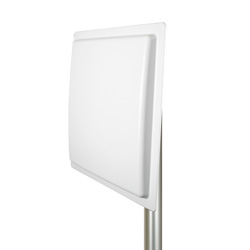If you’re not sure which side is up when it comes to antenna polarization, you are not alone. Antenna polarization may be one of the least understood properties of a wireless signal. If you are installing many wireless antennas in one location, like on a tower, polarization is an important piece of the puzzle that you will need to take into consideration. Here we give you a quick overview on antenna polarization.
Polarization is determined by the way an antenna is mounted, usually horizontally or vertically. To ensure optimal network performance only like-polarized antennas should be used in point-to-point wireless applications. It is possible to establish a wireless link using antennas with different polarities, but network performance and connectivity will suffer.
The main advantage or using different antenna polarization schemes is to reduce interference. For example, when mounting several antennas on a tower, it is best to stagger vertically and horizontally polarized antennas to reduce interference.
If horizontal or vertical polarization won’t work for your wireless application there are dual-polarized, cross-polarized and circular-polarized antenna options to explore.
Antenna Polarization Options:
Dual-polarized antennas feature two antenna elements in a single physical package (radome), one that is vertically polarized and one that is horizontally polarized. When properly installed, dual-polarized antennas can communicate with both vertically and horizontally polarized antennas. An advantage of a dual-polarity antenna is that you essentially get two antennas in one package which saves space and money. These antennas are often used with Multiple-in/Multiple-out (MIMO) wireless access points and CPE devices.
Cross-polarized antennas, sometimes referred to as X-Pol antennas, feature two elements in one package. One element is +45 deg; polarized and the other is -45 deg; polarized. The two opposing 45-degree angles of the elements produce a cross, or “X “ orientation. Using a cross-polarized antenna with vertically and horizontally polarized antennas further reduces interference.
Circular-polarized antennas have equal response to either horizontal or vertical-polarized antennas. These antennas are designed to either support right-hand or left-hand polarization to suit varied wireless connectivity applications. Using a circular-polarized antenna on a fixed access point can be beneficial if the linear-polarized remote links are constantly moving.
Making sure your antennas are correctly installed and using the proper polarity schemes is crucial to achieving optimal network performance.


